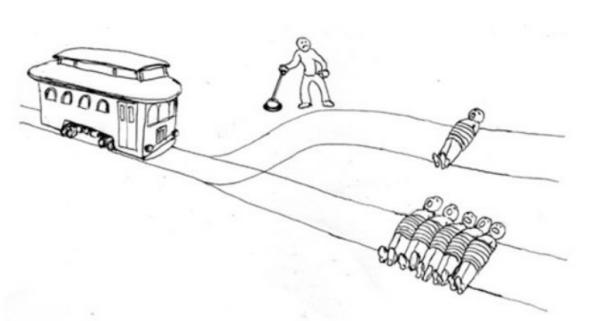Please stop worrying that driverless cars would run over kids
I mean it.Because a few days ago I saw a discussion on Twitter (*) that ran more or less like this:
- automatic cars are not going to be as smooth a transition as some folks think. * Because of enormous moral issues that can never be understood by an AI (Artificial Intelligence)
- Example: if a child jumps in front of the car, does the car swerve and possibly kill the passengers or run over the kid?
- [The real issue though] is whether driver error causes more deaths in these cases. Maybe the AI is able to more efficiently brake in time, etc.
- [because everything that] can be quantitatively defined will be mastered very quickly by AI
The “enormous moral issues” described in that Twitter thread are one instance of the “thought experiment in ethics” known as “Trolley Problem”, also defined, by the source for the image above, “the Internet’s Most Philosophical Meme”:

The problem is that, when speaking of driverless cars, the whole “trolley problem” approach consists, in a very non-negligible part, of barking up the wrong tree.
What is THE BEST WAY to not have cars running over kids?
The problem is not that the “moral issues that can never be understood by an AI” are not enormous. They are enormous. But they only exist if one continues to look only at the same problem that car makers, banking on our mental inertia, want us to consider, that is:
“how can we keep buying and using PRIVATE, or even shared, driverless cars in the SAME cities as today? The same cities that every serious forecast says will host a larger percentage of human population every year?"
That is not a question, or a problem, worth of high priority. A much better problem to tackle is:
“how do we make cities better and healthier places to live in, in spite of increasing urban population, and how could or should any modern tech, including driverless vehicles, be a part of the solution?"
Deal with that problem, and the “trolley problem” form of the “enormous moral issues AI cannot understand” practically disappear.
We have been successfully using subways and trains for more than 150 years now, without any need for AI, thanks to physical separation between the paths of pedestrians and (shared!) wagons. Rebuilding cities in that way today would make them better places to live. That is a priority, and a very urgent one in an age of accelerating urbanization. The fact that tackling that problem first would also make the trolley problem disappear is just a welcome, overdue side effect.
Even outside urban centers…
…just rising good old fences to the sides of each road, so that pedestrians can only cross the road in certain points. Doing that may very well be much more effective and much cheaper, not to mention totally free of countless privacy, security and surveillance issues, than building the huge infrastructure needed to make any Artificial Intelligence avoid any “trolley problem” in the real world. “Continues” [here](/2017/10/the-real-name-and-value-of-self-driving-cars/ and here http://stop.zona-m.net/2018/04/this-is-what-i-mean-by-treating-driverless-cars-like-trains/).
(*) which, for some reason, I cannot find now. If anyone has the link, please email me!)
Who writes this, why, and how to help
I am Marco Fioretti, tech writer and aspiring polymath doing human-digital research and popularization.
I do it because YOUR civil rights and the quality of YOUR life depend every year more on how software is used AROUND you.
To this end, I have already shared more than a million words on this blog, without any paywall or user tracking, and am sharing the next million through a newsletter, also without any paywall.
The more direct support I get, the more I can continue to inform for free parents, teachers, decision makers, and everybody else who should know more stuff like this. You can support me with paid subscriptions to my newsletter, donations via PayPal (mfioretti@nexaima.net) or LiberaPay, or in any of the other ways listed here.THANKS for your support!